Coffee is not just a drink, it’s a science and an art. In this guide, I’ll explore the vast landscape of coffee brewing methods. From the classic pour-over to the fancy siphon methods, I’ll discuss how each technique works its magic to turn those humble beans into liquid gold.
You’ll learn the mechanics behind each brewing technique, the tools you’ll need, and the unique flavors they produce. I’ll share my personal experiences and give you a balanced view of the advantages and drawbacks.
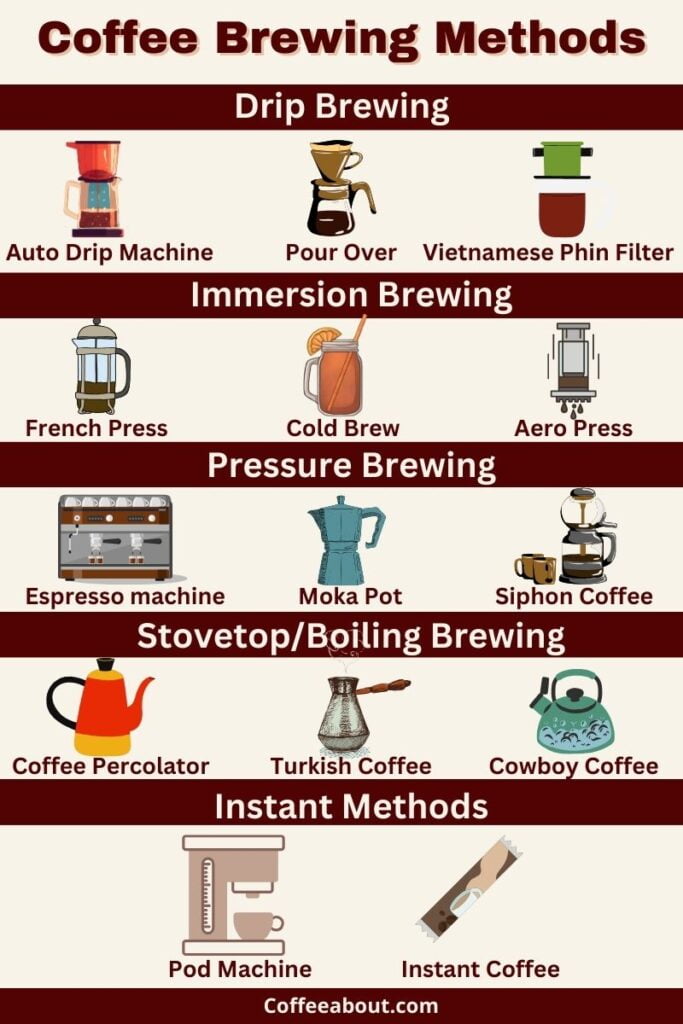
There are 4 main Coffee brewing Methods: drip, immersion, pressurized, and boiling. The 14 methods I’ve mentioned in this article are essentially different applications or combinations of these four fundamental techniques.
I – Drip brewing Methods
Drip brewing methods involve pouring hot water over coffee grounds in a filter and allowing the brewed coffee to drip slowly into a carafe or pot below.
1. Pour Over – Manual Drip
Pour Over is the best tasting brewing method for making simple black coffee – Hands down! It’s my go-to when I want to really savor the nuances of a fancy single-origin bean.
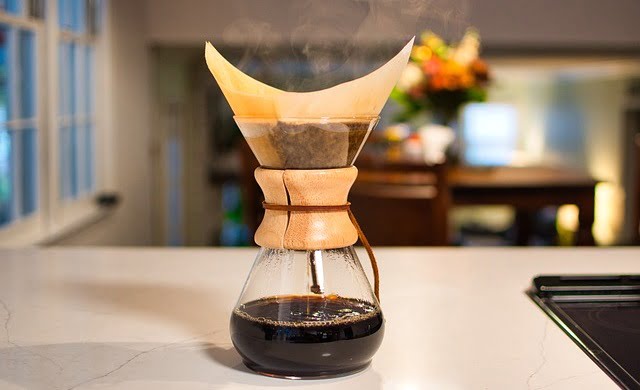
How Pour-Over works:
Pour Over is a manual and one of the oldest coffee brewing methods. It involves pouring hot water over ground coffee in a filter. The water slowly drips through the grounds, extracting the flavors and oils as it passes.
You start by pouring a small amount of water to “bloom” the coffee, which releases CO2 and prepares the grounds for optimal extraction. Then, you gradually add more water in a circular motion, maintaining a consistent flow rate.
The brewed coffee drips into a carafe or mug below, resulting in a clean, flavorful cup.
Equipment needed:
- Pour over dripper (like Hario V60, Kalita Wave, Chemex, Melitta, Clever Dripper, etc.)
- Paper filters
- Kettle (preferably gooseneck)
- Coffee grinder
- Scale (Optional for extra precision)
- Grind Size: The best grind size for Pour Over is medium-fine consistency, like granulated sugar or salt. This allows for proper extraction without over-extracting or clogging the filter.
- Brewing Time: The total brew time for a pour-over should be around 4-5 minutes, depending on the amount of coffee and your specific technique. This includes the initial bloom time and subsequent pours.
- Skills required: Pour over requires some practice to master. You’ll need to develop a steady pouring technique and learn to control variables like water temperature, pour rate, and timing.
Taste and Flavors
The best thing about pour-over coffee is its clean, bright flavor profile with excellent clarity and no bitterness. You can pick up on subtle notes like fruit, chocolate, or floral hints with a light to medium body and tea-like mouthfeel. I love how it brings out the complexity in light to medium roasts.
Best suited for
Pour-over is best suited for you if you enjoy the classic taste of simple black coffee. It provides complete control over all aspects of brewing and allows you to prepare coffee exactly the way you like.
Not suited for
Pour Over is not suitable if you’re always in a rush or prefer very strong coffee like espresso shots.
Pros
✔️ Allows for precise control over the brewing process
✔️ Produces a clean, flavorful cup that highlights bean characteristics
✔️ Relatively Simple and inexpensive equipment
Cons
❌ Not ideal for making large batches or quick cup of coffee
❌ Has a learning curve to master the technique
Read a guide on How to Make Pour Over Coffee
2. Auto Drip Coffee Machine
Now let’s talk about drip coffee machines – a classic kitchen gadget that everyone has at home. It’s so simple to use Just load the coffee grounds, hit a button, and boom – coffee’s ready!
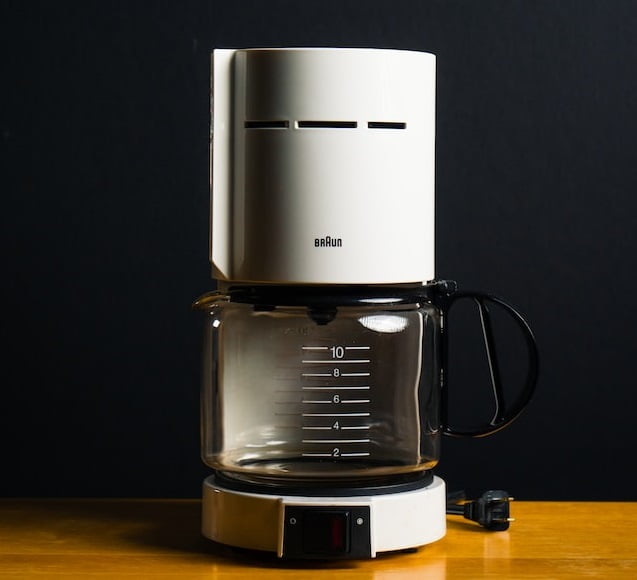
How Drip Machine works:
Auto drip coffee makers work on a similar principle to pour over, but with automation. Cold water is poured into a reservoir, which is then heated to the optimal brewing temperature (usually around 195-205°F).
The hot water is then pumped through a tube and distributed over the ground coffee in a filter basket. As the water drips through the grounds, it extracts the coffee’s flavors and oils.
The brewed coffee then drips down into a carafe or pot, which often sits on a heating plate to keep the coffee warm.
Equipment needed:
- Auto drip coffee maker
- Paper filters
- Coffee grinder (Optional – most folks prefer pre-ground coffee with drip machines)
- Grind Size: A medium grind size works best for Drip Coffee – think the consistency of regular sand. It’s the most common grind size in pre-ground coffees available in grocery stores.
- Brewing Time: The brewing time for an auto drip machine typically ranges from 5 to 10 minutes, depending on the machine and the amount of coffee being brewed.
- Skills required: Auto drip requires minimal skills. The main things are measuring the right amount of coffee and water, and keeping the machine clean.
Taste and Flavors
Auto-drip coffee tends to have a standard flavor profile with a medium body. It’s not as overwhelming or nuanced as pour-over, but it’s generally decent. Personally, I find it hits the spot when I want a straightforward, no-fuss cup of joe.
Best suited for
Auto drip is perfect for you if you want a convenient and consistent cup of coffee. It’s great for households or offices where multiple cups need to be brewed at once.
Not suited for
Auto Drip Machines aren’t ideal for folks who really love their coffee and want to experience different complex flavors of specialty beans, or for those who enjoy the whole process of making and adjusting their coffee by themselves.
Pros
✔️ Very convenient and easy to use
✔️ Can brew large quantities at once
✔️ Keeps coffee warm for extended periods
Cons
❌ Less control over brewing variables compared to manual methods
❌ Not bring out the best in high-quality, specialty coffees
3. Vietnamese Phin Filter
The Vietnamese Phin is similar to pour over but it uses metal filters instead of paper filters. It’s like a hybrid between French press and pour-over, and makes a strong and bold cup of coffee.
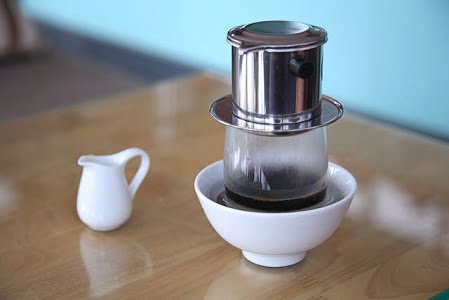
How it works:
The Phin is a small metal filter that sits on top of a cup. It consists of a chamber, a meta filter, and a lid. Ground coffee is added to the chamber, then hot water is poured over it. The coffee slowly drips through the filter into the cup below.
Equipment needed:
- Vietnamese Phin filter
- Cup
- Kettle
- Brewing Time: The Phin method typically takes about 3-5 minutes from start to finish, including the time for all the coffee to drip through.
- Grind size: The Phin works best with a medium grind size, similar to what you’d use for a Pour Over. This allows for slow extraction without clogging the filter.
- Skills required: Using a Phin requires some practice to get the right grind size and water-to-coffee ratio. You’ll also need to learn how to control the flow rate by adjusting the filter press.
Taste and Flavors
Vietnamese Phin coffee is known for its strong, bold flavor. The slow drip process extracts a lot of flavor, resulting in a full-bodied cup with low acidity. When made traditionally with robusta beans and sweetened condensed milk, it’s a deliciously refreshing treat.
Best suited for
The Phin is great for those who enjoy the ritual of manual pour over coffee but want something stronger.
Not suited for
This Phin method is not ideal if you prefer clean and more delicate coffee flavors
Pros
✔️ Produces a strong and rich coffee
✔️ Portable and requires minimal equipment
Cons
❌ May be too strong for some coffee drinkers
❌ Requires some practice to master the technique
Read a guide on Vietnamese Coffee Recipe
II – Pressurized Coffee Brewing Method
Pressurized coffee brewing methods use pressure to force hot water through coffee grounds. This pressure can come from pumps (like in espresso machines), steam pressure (moka pot), or vacuum pressure (Siphon).
4. Espresso
Espresso is the most popular coffee brewing method and it has its own genre. There are a variety of coffee drinks that are prepared using espresso as a base such as Latte, Americano, Cafe Mocha, and Cortado to name a few.
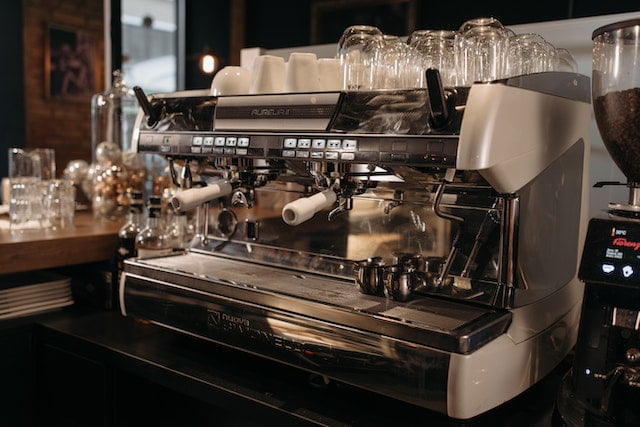
How it works:
Espresso involves passing hot water under high pressure through finely ground coffee. This yields a small but intense shot with a thick body and complex flavors compared to other brew methods.
The pressure extracts the coffee’s oils, flavors, and caffeine in a matter of seconds, resulting in a small amount of concentrated coffee topped with a layer of crema – the signature golden-brown foam on top of an espresso shot.
Espresso machines usually come with a built-in milk steamer that lets you make rich and creamy frothy milk for milky coffee drinks.
Equipment needed:
- Espresso machine
- Espresso grinder
- Tamper
- Portafilter
- Shot glass or espresso cup
- Grind Size: The best grind size for Espresso is very fine, almost like powdered sugar. This allows for proper extraction under high pressure without the water passing through too quickly.
- Brewing Time: A typical espresso shot takes about 25-30 seconds to brew, not including the time to heat the machine and prepare the coffee.
- Skills required: Making great espresso requires practice and attention to detail. You need to dial in the machine for various parameters like grinding, dosing, tamping, and timing of the shot.
Taste and Flavors
Espresso is intense, concentrated, and complex. It’s got a rich, bold flavor with a slightly syrupy body. You get the tasting notes of chocolate and nuts to fruit and caramel, depending on the beans. The crema adds a smooth, creamy texture and a bit of bitterness that balances out the shot.
Best suited for
Espresso is perfect for you if you like small concentrated shots of coffee or you want to make delicious milky coffee drinks like Cappuccino or Latte.
Not suited for
Espresso is not great if you prefer a full serving of Black coffee with a mild and bright taste.
Pros
✔️ Perfect for making milky coffee drinks (lattes, cappuccinos, etc.)
✔️ Quick brewing time once the machine is heated – Makes it perfect for cafes and commercial spaces
Cons
❌ Requires expensive equipment and regular maintenance
❌ Has a steep learning curve to master
5. Moka Pot – Stovetop Espresso maker
The Moka Pot is a classic and straightforward brewing method that delivers a rich, bold, and flavorful cup of coffee resembling an Espresso shot. It’s my go-to when I want a strong cup that packs a punch but doesn’t require a heavy machine or barista degree to make.
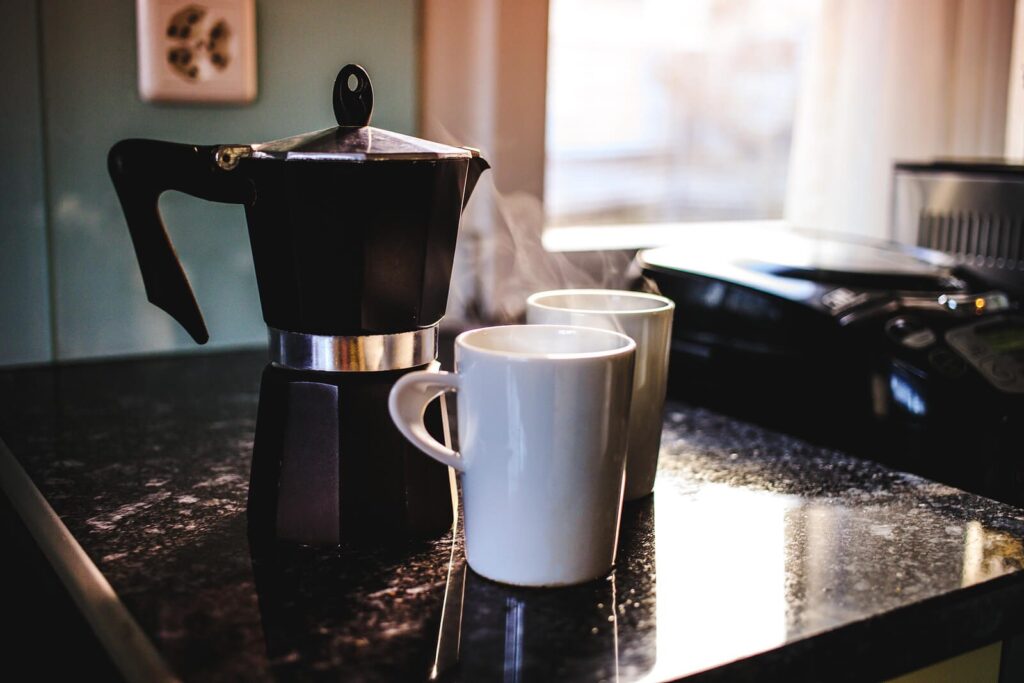
How it works:
The Moka pot uses steam pressure to brew coffee. It consists of three chambers: the bottom for water, the middle for ground coffee, and the top for brewed coffee.
As the water in the bottom chamber heats up, it creates steam, which increases pressure. This pressure forces the hot water up through the coffee grounds in the middle chamber.
The brewed coffee then flows into the top chamber through a small pipe. The process stops when you hear a gurgling sound, indicating that all the water has been pushed through the grounds.
Equipment needed:
- Moka pot
- Stove or heat source
- Coffee grinder
- Grind Size: Moka pots work best with a medium-fine grind, slightly coarser than espresso but finer than drip coffee.
- Brewing Time: Brewing with a Moka pot typically takes about 5-10 minutes, including the time it takes to heat the water and for the coffee to brew and collect in the upper chamber.
- Skills required: Using a Moka pot requires some practice to get the timing right and avoid over-extraction. You’ll need to learn to remove it from heat at the right moment and cool the base quickly to stop the brewing process.
Taste and flavors
Moka pot coffee is strong and intense, with a rich, bold flavor that’s similar to espresso but not quite as concentrated. It has a full body and can sometimes have a slightly bitter edge, especially if over-extracted. I love how it gives me that espresso-like kick with a bit more volume.
Best suited for
Moka pots are great for those who enjoy strong coffee similar to espresso but don’t want to invest in an expensive espresso machine. They’re also ideal for camping or travel due to their portability.
Not suited for
Moka Pot is not best for you if you prefer lighter, more delicate coffee flavors
Pros
✔️ Produces strong, rich coffee similar to espresso
✔️ Affordable and portable
Cons
❌ Can be tricky to master and easy to over-extract
❌ Slightly Bitter taste
Read a Guide on How to use a Moka Pot Coffee Maker
6. Siphon – Vacuum Method
The siphon coffee maker is a vacuum brewing device similar to stovetop coffee makers. I love it because it’s not just about making coffee – it’s a whole theatrical experience that gives me a feel like a coffee alchemist in my kitchen.
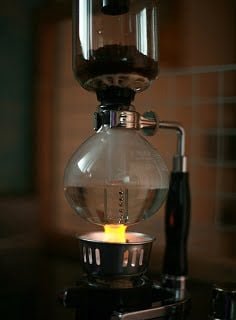
How it works:
The siphon brewer uses vacuum pressure to brew coffee. It consists of two chambers: a lower bowl and an upper chamber with a filter.
Water is placed in the lower bowl and heated. As it heats, vapor pressure forces the water up into the upper chamber where the coffee grounds are added. The mixture is stirred and left to steep.
When the heat source is removed, the vacuum created pulls the brewed coffee back down through the filter into the lower bowl.
Equipment needed:
- Siphon coffee maker
- Heat source (butane burner or halogen beam heater)
- Filter (cloth or paper)
- Coffee grinder
Grind Size: Siphon coffee works best with a medium-fine grind, similar to what you’d use for drip coffee.
Brewing Time: The entire siphon brewing process typically takes about 5-8 minutes, including heating the water, steeping, and the drawdown phase.
Skills required: Siphon brewing requires attention to detail and practice. You’ll need to master temperature control, timing, and the right dose to get consistent results.
Taste and Flavors
Siphon coffee is known for producing a clean, crisp, and complex cup. The full immersion brewing combined with vacuum filtration results in a light-bodied coffee with vibrant flavors. I love how it brings out the complex and fruity flavors in light to medium roasts
Best suited for
Siphon coffee is perfect for coffee enthusiasts who enjoy the brewing process as much as the final product. It’s also great for those who appreciate lighter, more nuanced coffee flavors.
Not suited for
Siphon is not ideal if you want a quick, easy cup of coffee or prefer very strong, full-bodied brews.
Pros
✔️ Produces a clean, flavorful cup of coffee
✔️ Offers a unique, visually appealing brewing experience
Cons
❌ Time-consuming and requires attention throughout the process
❌ Can be fragile and difficult to clean
III – Immersion Coffee brewing methods
Immersion coffee brewing methods involve fully submerging coffee grounds in water for a set period, allowing for a strong extraction.
7. French Press
A French press is a simple yet elegant way of brewing coffee. I’m a big fan of French press coffee when I want something rich and robust – the full-bodied flavor really hits the spot.
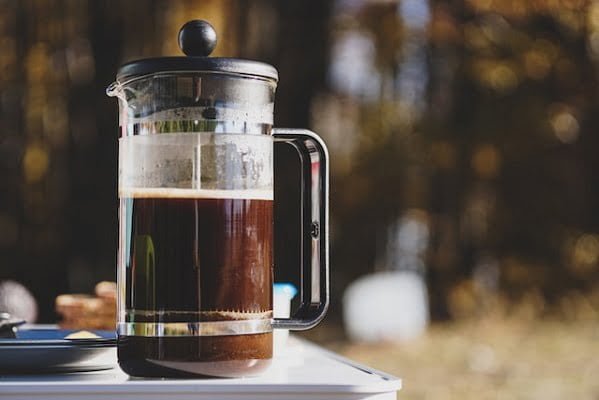
How it works:
The French Press is an immersion coffee brewing method that involves soaking coarsely ground beans in hot water and pressing the coffee through a metal filter to make a full-bodied and flavorful drink.
French Press makes thick and full-bodied Coffee drinks as it doesn’t use any paper filter and the caffeine content is also a little higher because of the long immersion process.
Equipment needed:
- French press
- Kettle
- Coffee grinder
- Grind Size: French press requires a coarse grind, about the consistency of sea salt or coarse breadcrumbs. This prevents the grounds from passing through the metal filter and into your cup.
- Brewing Time: The total brewing time for a French press is typically 4-5 minutes. This includes a brief bloom period of about 30 seconds after the initial pour, followed by the main steeping time.
- Skills required: French press is relatively simple, but you’ll need some practice to select the right grind size, water temperature, and steeping time.
Taste and Flavors
French press coffee is known for its bold, rich flavor and full body. The metal filter allows oils and fine particles to pass through, giving the coffee a slightly gritty texture (which some people might not like). You’ll often pick up on deeper, darker notes like chocolate, nuts, or earthiness. I love how it brings out the intensity in dark roasts – it’s like a punch of flavor in every sip.
Best suited for
French press is ideal for those who enjoy a strong, full-bodied coffee. It’s also great simple equipment for your camping trips.
Not suited for
French Press might not be the best choice for folks who like their coffee light and clean or for those with heart or blood pressure issues since French Press coffee contains high amounts of cafestol.
Pros
✔️ Produces a rich, full-bodied cup of coffee
✔️ Relatively inexpensive and portable
Cons
❌ Can leave sediment in the cup, which some people don’t enjoy
❌ May have some health risks for some people
8. Cold Brew – Prolonged Steeping
Cold brew is the slowest coffee brewing method that takes a whole day to brew and is never exposed to heat. It’s my summer go-to coffee drink – smooth, refreshing, and way less acidic than hot coffee.
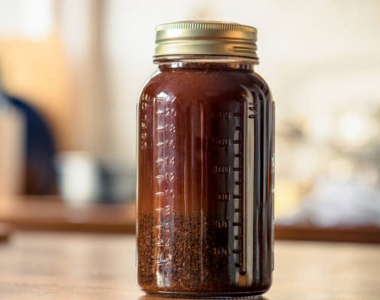
How it works:
Cold brew is made by steeping coarsely ground coffee in room-temperature water for 12-24 hours. Unlike hot brewing methods, cold brew relies on time rather than heat to extract the coffee’s flavors and caffeine.
After steeping, the mixture is strained to remove the grounds, leaving a smooth coffee concentrate that can be diluted with water or milk and served over ice.
Equipment needed:
- Large container or cold brew maker
- Coarse mesh strainer or cheesecloth
- Coffee grinder
- Grind Size: Cold brew requires a coarse grind, similar to that used for French press. This prevents over-extraction and makes the filtering process easier.
- Brewing Time: Cold brew typically steeps for 12-24 hours, depending on your desired strength, so it is an overnight brewing process.
- Skills required: Cold brew is pretty forgiving and doesn’t require much skill. The main things are choosing the right grind size and patience to wait for a day.
Taste and Flavors
Cold brew has a smooth, mellow flavor profile with very low acidity. It highlights the sweet chocolatey and nutty notes in coffee while downplaying some of the brighter, fruitier notes you get in hot coffee. I love how it brings out the subtle flavors in dark roasts without any bitterness – it’s like liquid velvet.
Best suited for
Cold brew is ideal for those who enjoy smooth and less acidic iced coffee drinks. It tastes so much better and refreshing compared to your normal hot brewed iced coffee.
Not suited for
If you’re the kind of person who’s always in a hurry, you might not like this extra-long brewing process. Plus, cold brew is best suited for iced coffee drinks and should not be reheated.
Pros
✔️ Makes refreshing less acidic coffee
✔️ Don’t require any brewing equipment
✔️ Can be made in large batches and stored for a week in a fridge
Cons
❌ Requires significant advance planning due to long brew time
❌ Uses more coffee grounds than other brewing methods
Here’s a guide on How to Make Cold Brew Coffee
9. Aeropress – Immersion Portable Method
The AeroPress is a compact, portable coffee maker that uses hand pressure to brew coffee. I absolutely love my AeroPress for travel as It lets me make a decent cup of coffee anywhere, anytime.
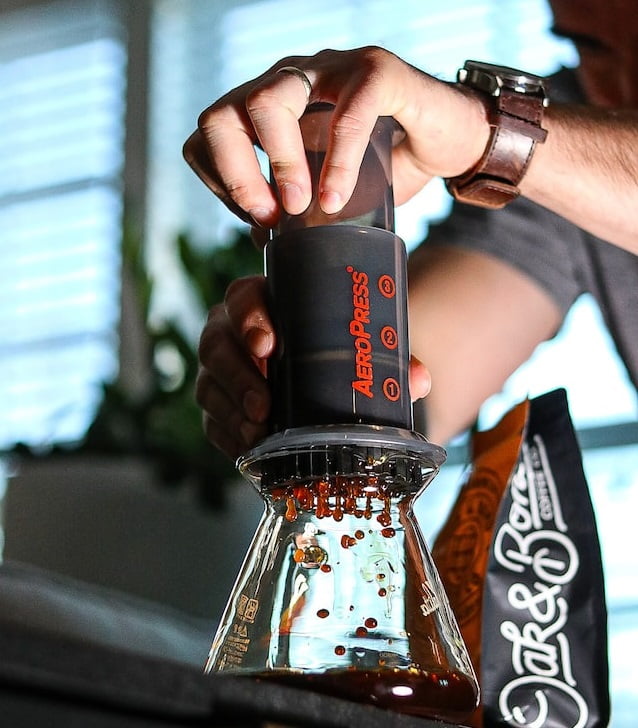
How it works:
The AeroPress consists of two nested cylinders. Ground coffee and hot water are added to the inner cylinder, which has a filter at the bottom.
After a short steep, the outer cylinder is used as a plunger to force the water through the grounds and filter into a cup below. The air pressure created during this process results in a quick extraction and produces a smooth, rich coffee.
Equipment needed:
- AeroPress
- AeroPress filters
- Coffee grinder
- Kettle
- Grind Size: The AeroPress works well with a medium-fine to fine grind, similar to what you’d use for drip coffee or slightly finer. This allows for quick, efficient extraction.
- Brewing Time: Total brewing time with an AeroPress is typically 2-3 minutes, including steeping and pressing. It’s one of the quickest brewing methods available.
- Skills required: The AeroPress is fairly forgiving, but you’ll need to experiment with grind size, water temperature, and pressing technique to find your perfect cup.
Taste and Flavors
AeroPress coffee is smooth, clean, and full-flavored. It produces a cup that’s less acidic than drip coffee but with more body – many also refer to it as portable espresso. I love how it gives me a rich, almost espresso-like concentration but without any bitterness.
Best suited for
The AeroPress is ideal for travelers, campers, or anyone who wants a quick, easy way to make a single serving of great coffee.
Not suited for
This method might not be the best choice if you regularly need to make large batches of coffee or if you prefer a very light, delicate brew with all the complex flavors.
Pros
✔️ Highly portable and durable
✔️ Produces a clean, smooth cup of coffee
✔️ Quick and easy to use and clean
Cons
❌ Only makes 1-2 cups at a time
❌ Requires special circular filters
Read a Guide on AeroPress Coffee Maker
IV – Stovetop/Boiling Coffee Brewing Methods
Stovetop/boiling coffee brewing methods involve heating water and coffee grounds together until boiling, often resulting in a strong and bitter brew.
10. Turkish Coffee – Strongest Brewing Method
Turkish coffee is a traditional method of brewing unfiltered coffee. I absolutely love it when I want something intensely flavored and strong.
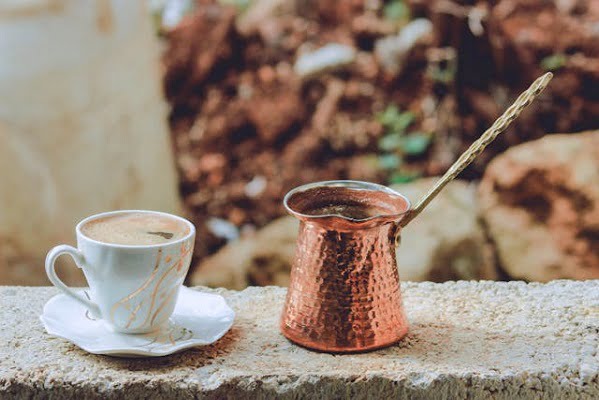
How it works:
Turkish coffee is brewed by mixing finely ground coffee with water (and sometimes sugar) in a special pot called a cezve or ibrik.
The mixture is heated slowly, allowing the coffee to foam up. As it nears boiling, it’s removed from heat, and the foam is spooned into cups. The process is repeated 2-3 times to create more foam. Finally, the coffee is poured into small cups
Equipment needed:
- Cezve (Turkish coffee pot)
- Very fine coffee grounds
- Heat source
- Grind Size: Turkish coffee requires an extremely fine grind, even finer than espresso. It should be almost powder-like, similar to the consistency of flour.
- Brewing Time: The entire process of brewing Turkish coffee typically takes about 3-5 minutes, including the time to heat the water and create the foam.
- Skills required: Making great Turkish coffee requires practice to achieve the right foam and avoid over-boiling.
Taste and Flavors
Turkish coffee is incredibly strong, rich, and flavorful. It has a thick, almost syrupy body and a very intense taste. The fine grounds left in the cup contribute to its robust flavor and can add a pleasant grittiness to the last sips. I love how it lingers on your palate – it’s like a coffee experience that keeps on giving long after you’ve finished your cup.
Best suited for
Turkish coffee is perfect for those who enjoy very strong, intense coffee and don’t mind a bit of sediment.
Not suited for
This method might not be ideal for those who prefer cleaner and lighter coffee.
Pros
✔️ Produces a very strong, flavorful coffee
✔️ Rich in tradition and cultural significance
Cons
❌ Can be bitter if not prepared correctly
❌ Leaves sediment in the cup, which some may not enjoy
Read a Guide on How to make Turkish Coffee
11. Cowboy Coffee – The oldest Brewing Method
Cowboy coffee is the oldest coffee brewing method – used for centuries when fancy brewing equipment wasn’t a thing. No filters, no paper, no machines – just you, a pot, heat source, and some intensely flavored cowboy brew. It’s a little gritty and bitter, but that’s part of its rustic charm if you ask me.
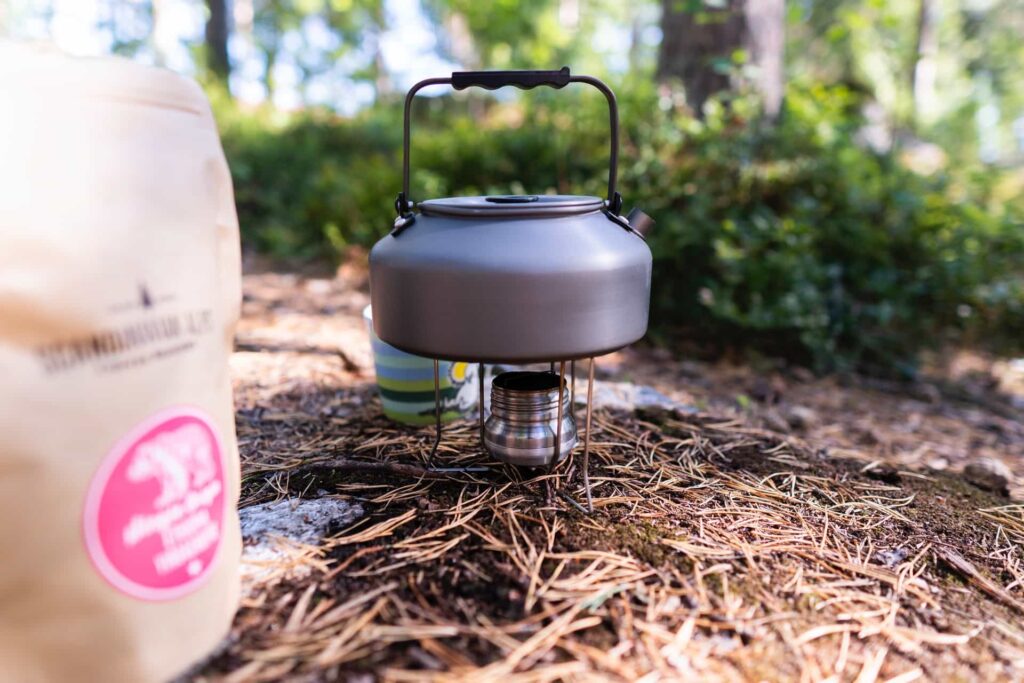
How it works:
Cowboy coffee is made by boiling coarse ground coffee directly in water. Typically, you bring water to a boil in a pot over a fire, and remove it from the heat. Then, you add the coffee grounds and let it steep for 3-4 minutes to extract the flavors.
The coffee is then carefully poured into cups, trying to leave as much of the sediment behind as possible.
Equipment needed:
- Pot or kettle
- Heat source (campfire or stove)
- Brewing Time: Cowboy coffee typically takes about 5-10 minutes to brew, depending on how quickly you can bring the water to a boil.
- Grind size: A coarse grind is best for cowboy coffee. This helps minimize the amount of grounds that end up in your cup and reduces bitterness.
- Skills required: Making good cowboy coffee requires some practice. You need to learn the right coffee-to-water ratio, timing, and pouring technique to minimize grounds in your cup.
Taste and Flavors
Cowboy coffee is known for its strong, bold, and bitter flavors. There’s often a gritty texture from the fine particles that make it into your cup. It’s not the smoothest coffee you’ll ever taste, but it has a certain rugged charm. When I’m camping and want that authentic outdoorsy experience, nothing beats brewing coffee the way the cowboys did – even if it means risking a mouthful of grounds!
Best suited for
Cowboy coffee is ideal for camping, backpacking, or any situation where you don’t have access to regular coffee-making equipment.
Not suited for
Cowboy isn’t suitable if you prefer smooth, clean-tasting coffee.
Pros
✔️ Requires minimal equipment
✔️ Can be made anywhere you can build a fire
Cons
❌ Often results in bitter coffee with grounds in the cup
❌ Difficult to achieve consistency in taste
12. Coffee Percolator
Percolator coffee takes me back to my grandparents’ house – it’s a classic method that’s been around forever. I’ll admit, it’s not my favorite way to brew because it can be pretty bitter, but it’s got that nostalgic charm.

How it works:
A percolator has a bottom chamber for water and an upper chamber for coffee grounds, with a vertical tube connecting them. As the water heats, it’s forced up the tube and sprays over the coffee grounds.
The brewed coffee then drips back down into the water chamber, where it’s cycled through again. This process repeats, continually extracting more from the grounds, until the desired strength is reached or the heat is removed.
Equipment needed:
- Percolator
- Heat source (stove or electric)
- Brewing Time: Percolator coffee typically takes about 7-10 minutes to brew, depending on your desired strength and the specific percolator.
- Grind size: A coarse or medium coarse grind size works best for percolators. This helps prevent grounds from seeping through the basket and reduces the risk of over-extraction.
- Skills required: Using a percolator requires some practice to get the timing right. You need to learn when to remove it from heat to avoid over-extraction and excessive bitterness.
Taste and Flavors
Percolator coffee is known for its strong, often bitter flavor. The continuous recycling of the brewed coffee through the grounds can lead to over-extraction, resulting in a robust but sometimes harsh taste.
Best suited for
Percolators are great for those who enjoy strong coffee and don’t mind a bit of bitterness. They’re also ideal for camping or large gatherings where you need to make a lot of coffee at once.
Not suited for
This method isn’t suitable for coffee connoisseurs who prefer smooth flavors or those who are sensitive to bitter tastes. It’s also not ideal if you want precise control over the brewing process.
Pros
✔️ Can brew large quantities of coffee
✔️ Durable and often portable
Cons
❌ Often produces bitter, over-extracted coffee
❌ Difficult to achieve consistency in flavor
❌ Less control over brewing variables
Read a Guide on How to make Coffee in a Percolator
V – Quick Coffee brewing methods
Quick coffee brewing methods, like pod machines or instant coffee, offer fast and convenient ways to make a cup of coffee with minimal effort and clean-up.
13. Single Serve Pod Coffee Machines
Single-serve pod machines work similarly to auto drip or espresso machines but with coffee pods instead of coffee grounds. I love them for those mornings when I’m in a rush – just pop in a pod, press a button, and bam! Coffee’s ready before I can even find my keys.

How it works:
Single-serve pod machines, like Nespresso and Keurig, use pre-packaged pods or capsules filled with ground coffee. The machine punctures the pod and forces hot water through it.
In Nespresso machines, this process is similar to espresso brewing, while Keurig machines use a lower pressure more akin to drip coffee.
Equipment needed:
- Single-serve pod machine
- Coffee pods or capsules
- Brewing Time: The pod machines are incredibly quick, typically brewing a cup in 30 seconds to 1 minute once they’re warmed up.
- Skills required: These machines require virtually no skill to operate. The main thing is choosing pods you enjoy and keeping the machine clean.
Taste and Flavors
The taste of pod coffee can vary widely depending on the brand and type of pod you’re using. Generally, it’s consistent and decent, though it lacks the depth and complexity of freshly ground coffee.
Best suited for
Single-serve pod machines are ideal for people who prioritize convenience and speed over taste. They’re great for busy individuals, offices, or commercial spaces
Not suited for
You will not like pod machines if you’re a die-hard coffee lover who really enjoys the rich flavors and the freshness of coffee beans.
Pros
✔️ Extremely quick and convenient
✔️ Decent and Consistent taste every time
Cons
❌ More expensive per cup than other brewing methods
❌ Limited control over brewing variables
14. Instant Coffee
Instant coffee is a powder that you can dissolve in hot water, but I’ll be honest – I’m not a big fan of the taste. It’s my last resort when I need caffeine fast and have absolutely no other options.

How it works:
Instant coffee is made by brewing coffee normally and then removing the water through freeze-drying or spray-drying. The resulting powder or crystals can be dissolved in hot water to make a quick cup of coffee.
Equipment needed:
- Instant coffee powder
- Kettle or hot water source
Taste and Flavors
Instant coffee generally has a less complex flavor profile compared to freshly brewed coffee. It can taste somewhat flat or have a slightly burnt or bitter edge. Personally, I find that even the best instant coffee tastes a bit like a pale imitation of the real thing – it’s missing that depth and richness I love in a good cup of joe.
Best suited for
Instant coffee is ideal for situations where speed and convenience are the top priorities, like camping, traveling, or quick breaks at work where brewing equipment isn’t available.
Not suited for
This method won’t satisfy coffee enthusiasts or anyone who appreciates the nuances and flavors of freshly brewed coffee.
Pros
✔️ Extremely quick and convenient
✔️ Portable and requires no special equipment
Cons
❌ Lackluster taste
❌ Limited variety and quality options
Also Read: What is Instant Coffee and How is it Made?
Final Thoughts
Alright, coffee enthusiasts, we’ve just explored 14 awesome ways to brew coffee at your home! From quick and easy to complex and artisanal, there’s a method out there for everyone.
Now, I’m curious – what’s your go-to coffee brewing method? Is there a method you’re itching to try? Or maybe you’ve got questions about one of these brewing techniques? Drop a comment below and let’s keep this coffee conversation going!
Read interesting Coffee guides




I have a Keurig, but use Java Jigs & grind my own coffee (no pods to landfill, as cannot recycle where I live). Java Jigs use the world’s smallest Melita filters. I can just dump waste into compost bin. I use medium grind (13–15) on a burr grinder. Works almost as fast as prefilled pods.
This is great! You get all the convenience of a Keurig but with freshly ground coffee AND zero waste. Thanks for sharing those specifics about the amount and the grind size!
The siphon method looks amazing. Like a science experiment on my counter. I’m definitely trying this next. Your point about it being theatrical really appeals to me. Coffee should be an experience, not just a routine.
Great guide! I’ve tried pour-over and French press, but which one do you think brings out more flavor in light roasts?
What’s the thought behind putting egg shells in the pot when making cowboy coffee? Does the calcium affect the bitterness?
Yeah, it’s an old cowboy trick. The eggshells help settle the coffee grounds but don’t actually do much for bitterness though. Eggshells are porous and slightly alkaline. When you add them to boiling coffee, they absorb some of the fine grounds and help weigh them down so they sink to the bottom of the pot. Cleaner cup, fewer grounds in your mouth that might actually reduce some of the bitterness too.